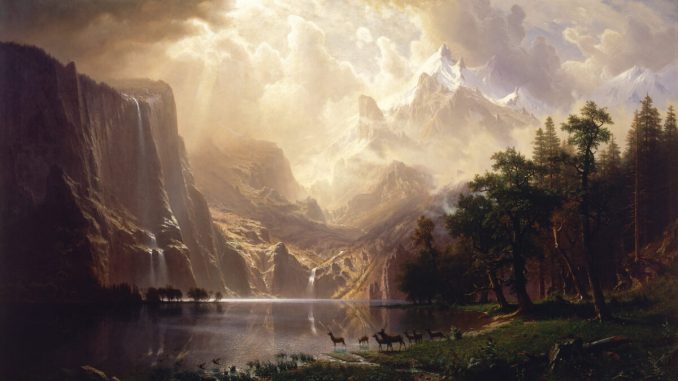
Come forth into the light of things, let nature be your teacher. —William Wordsworth
In times when “progress” charts a potentially perilous course for humanity, it’s the role of art to remind us of our connection to life, both inside and outside ourselves. In the 18th and 19th centuries, as the industrial revolution transformed the human experience in the Western world, artists had serious concerns about its impact on both nature and the human soul. When governments and industries lead humanity forward unconsciously, it’s the individual’s thoughts and connection to the divine that act as a light in the darkness.
The scientific rationalism and reductionism of the “Enlightenment” period persuaded a large chunk of humanity that the profound mystery of life could eventually be categorized, explained, mechanized, and reduced in service of man. The pride of man’s intellect, invention, and progress promised dominion over nature and prosperity for all. Artists, writers, and philosophers of the Romantic period were greatly at odds with this way of thinking. For Romanticists, the natural world was a source of sublimely transcendental beauty and meaning. Its mystery and miraculous complexity were perennial contemplative food for the soul. Their works sought to illustrate this belief and restore man’s connection to the divine, inside and out.
Divine Relationship With Nature
Artists of the Romantic period in Europe were witnessing a disturbing transformation firsthand. As urban centers grew, severe economic impacts, due to the paradigm shift in production, displaced farmers who could no longer afford the way of life they had always known. Artists such as John Constable, the wealthy son of a rural landowner, painted scenes from agrarian life in an attempt to elevate it in the hearts and minds of people who were seeing it become more endangered. To Constable, “painting is but another word for feeling,” and he clearly shared the Romanticist’s feeling that people needed to be reminded of their intrinsic connection to nature.
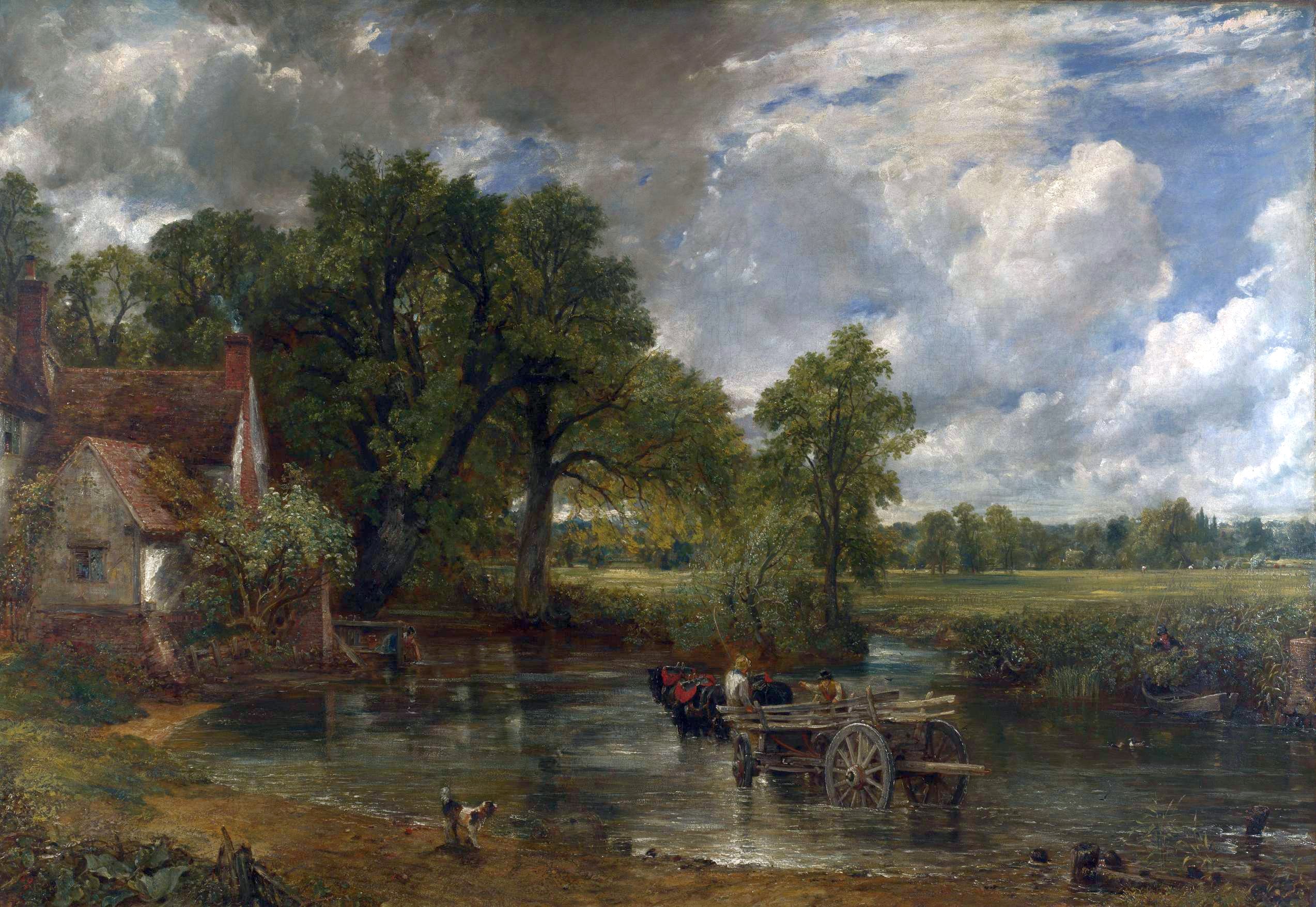
Paintings like “The Haywain” were a celebration of pastoral life. Figures were not the central focus of his landscapes, but rather part of a larger synergistic whole. People are portrayed as beings interacting within the larger being of the landscape. Great distances and impressive clouds feature prominently as though to invoke a sense of this larger being as the figures go about their work. Light filters from the sky through the leaves and across the surface of the water. Life is imbued throughout Romantic paintings without need for a definitive figurative focus. It was the unity of man with nature that artists like Constable aimed to religiously depict. In their pantheistic view, when nature was abandoned or trampled, the human spirit would also be in turmoil.
In Germany, Caspar David Friedrich painted scenes with similar Romantic reformational themes. Among the first northern European transcendental landscape artists, Friedrich passionately stated, “The artist should not only paint what he sees before him, but what he sees within him.” This spiritual and philosophical imperative was indicative of the Romantic commitment to achieving individual states of consciousness that revealed the divine presence in nature. Samuel Taylor Coleridge wrote at the time that “deep thinking is attainable only by a man of deep feeling, and all truth is a species of revelation.”

Friedrich’s most renowned work, “Wanderer above the Sea of Fog” from 1818, invites viewers on a quest for revelation through solitary union with nature. The anonymous central figure has his back turned, allowing the viewer to engage him as an archetypal explorer looking out into a mountainous landscape enshrouded in clouds. This solitary figure stands perched above the clouds, looking as though he were ready to step into a higher dimension of existence—to disappear into eternity and union with God. Friedrich’s painting strives to fulfill the Transcendentalist words of author Ralph Waldo Emerson who wrote,
“Standing on the bare ground, my head bathed by the blithe air, and uplifted into infinite space, all mean egotism vanishes. I become a transparent eyeball; I am nothing; I see all; the currents of the Universal Being circulate through me; I am part or particle of God.”
Romanticism Spreads Westward
America held the promise of a new world full of undisturbed natural beauty and a vast potential for expansion. Proponents of Manifest Destiny held that it was God-given destiny that the new inhabitants of America’s east coast spread westward. A group of Romanticist painters on the east coast, known as the Hudson River School, questioned the morality of America’s direction while also striving to depict the holiness they perceived in America’s breathtaking landscapes.
Thomas Cole, regarded as the leader of the Hudson School, emigrated with his family to the United States in 1818. Known best for his allegorical landscapes in both series “The Course of Empire” and “The Voyage of Life,” Cole painted natural scenes deeply imbued with philosophical and spiritual meaning. One of his most famous landscapes is known as “The Oxbow,” and depicts a popular view from Mount Holyoke in Northampton, Massachusetts in 1836.
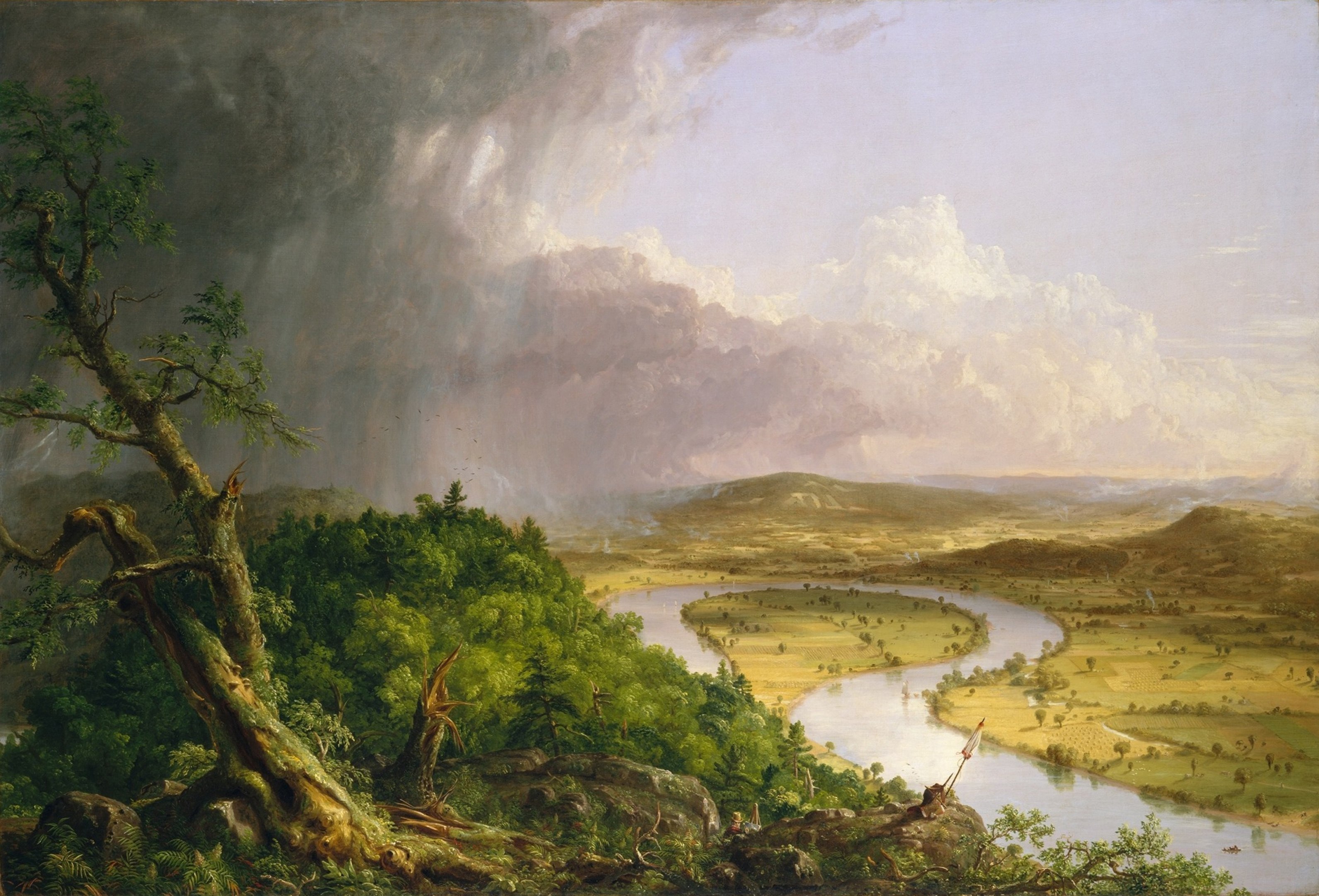
In his “Essay on American Scenery,” Cole stated, “The imagination can scarcely conceive Arcadian vales more lovely or more peaceful than the valley of the Connecticut—its villages are rural places where trees overspread every dwelling, and the fields upon its margin have the richest verdure.” This sentiment is captured on the right side of his split composition “The Oxbow.” On the left, a dark storm with lightning enshrouds a wild area of untamed beauty. It seems to be a divine warning that humanity dare not take more than what it needs from the natural world. A small self-portrait of the painter can be found somewhat hidden on the mountain, looking back at the viewer ambivalently as if to pose the question, “Can humanity limit its destructive tendencies?”
Cole further expresses his respect for undisturbed nature by saying, “There are those who regret that with the improvements of cultivation, the sublimity of the wilderness should pass away: for those scenes of solitude from which the hand of nature has never been lifted, affect the mind with a more deep-toned emotion than aught which the hand of man has touched. Amid them the consequent associations of God the creator—they are his undefiled works, and the mind is cast into the contemplation of eternal things.”
According to Associationist doctrine at the time, God was present in the landscape, and this presence could be experienced in America particularly because it was “untamed.” This belief elevated the landscape to a divine being in the minds of the Romanticists, and they endeavored to paint it as such. Nature to them was sublime, which philosopher Edmund Burke defined as “awe mixed with terror.” Foreboding weather and dramatic chiaroscuro enhanced this sense of awe and terror in paintings of Thomas Cole and Albert Bierstadt. The force of nature commands the respect and humility of humanity while simultaneously providing us abundant sustenance and astonishing beauty. It’s difficult to look at paintings like these and not see the hand of the divine.
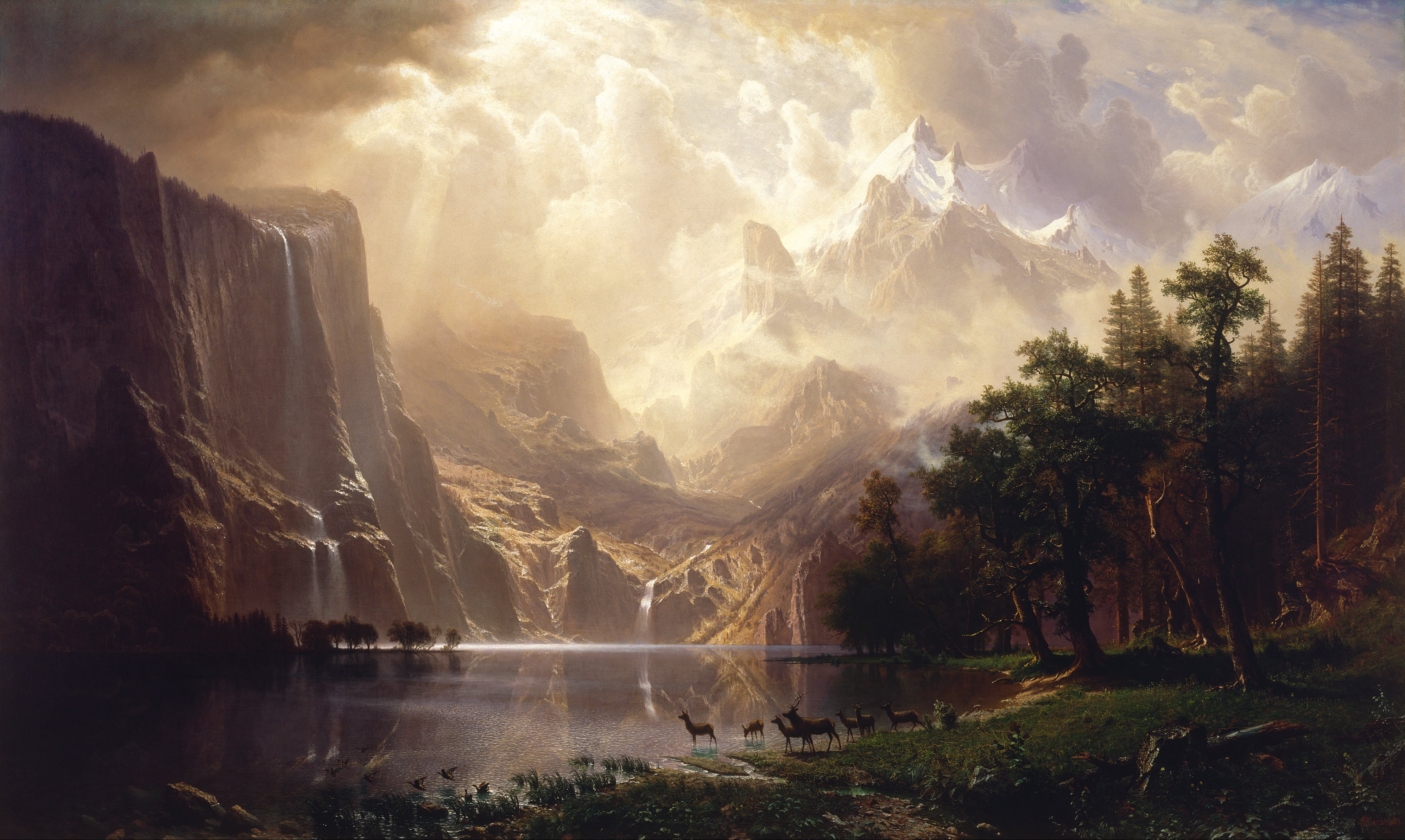
Portraying the profound beauty of lands west of the Rocky Mountains, Albert Bierstadt gave Americans increased impetus to travel westward. The sublime, almost otherworldly scenes he painted are works that capture the transcendental magnificence of the natural wonders from which he gained inspiration. One can only imagine the revelry these images would have inspired in people who had never seen such sights. In our modern times, where every computer comes with Yosemite desktop background options, it’s hard to imagine the overwhelming feeling paintings like “Among the Sierra Nevada Mountains” would impress on viewers. For those that experienced the divine through nature, it must have been akin to religious worship.
Like temples of worship, these natural wonders were to be revered and not tarnished. Westward expansion enabled artists to see such sights while also making them apprehensive about humanity’s growing impact on the untamed world. The railway system of trains that spread across America’s landscape was called “a winged horse or fiery dragon” by the American philosopher Henry David Thoreau. The train tore through landscapes in a powerful, loud, and efficient new way. The reality of the conquest of Native Americans must not have sat well in the conscience of many Americans, including Bierstadt, who respectfully painted them at peace amidst the landscape in several of his great works. Nevertheless, “progress” plowed forward, and those captains of industry leading the charge were ironically also the most eager and able to purchase Bierstadt’s paintings.
Protecting Parts of Paradise
Works and words from Romanticist and Transcendentalist artists and writers must have provided some of the momentum toward the beginning of the national park system in the United States. The late 19th and early 20th centuries saw an ever-increasing need and desire to preserve America’s natural wonders. In 1832, artist George Catlin wrote that these areas needed to be preserved “by some great protecting policy of government … in a magnificent park, a nation’s park, containing man and beast, in all the wild and freshness of nature’s beauty!” It was the fruition of this idea that created protected places where millions of people continue to pilgrimage every year as though to commune with the divine in nature.
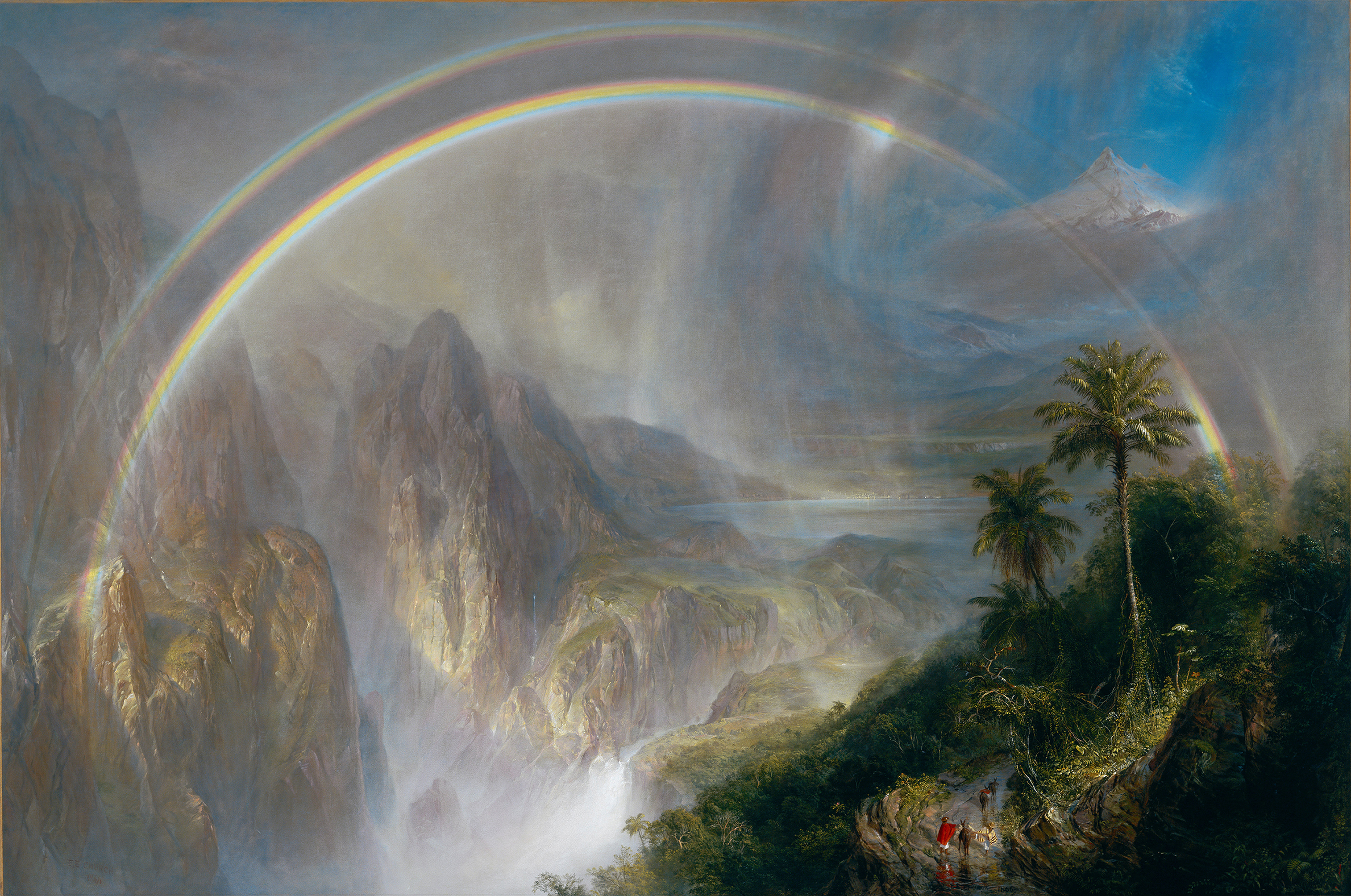
Frederic Edwin Church ventured abroad in search of the sublime with voyages that took him to the tropics, South America, Mexico, Europe, the Middle East, Newfoundland, and other places. He brought back wild scenes that were enhanced in sublimity by his Transcendentalist imagination. “Rainy Season in the Tropics” is a masterful tribute to the creative beauty of nature heightened for dramatic effect. A double rainbow and a dreamlike, light-filled landscape give the viewer the sense of a land of Edenic beauty.
Church was also highly regarded for American scenes such as “A Country Home,” depicting an area on the edge of the Hudson River. In true Romantic form, small figures are painted as details in a grand, harmonious environment. Small children are seen fishing with their mother waiting on shore for them to come to dinner, and a colorful sunset embraces everything approvingly in its warm glow. Cows graze in open grass, and the natural world is enhanced and largely undisturbed by the presence of the people therein.
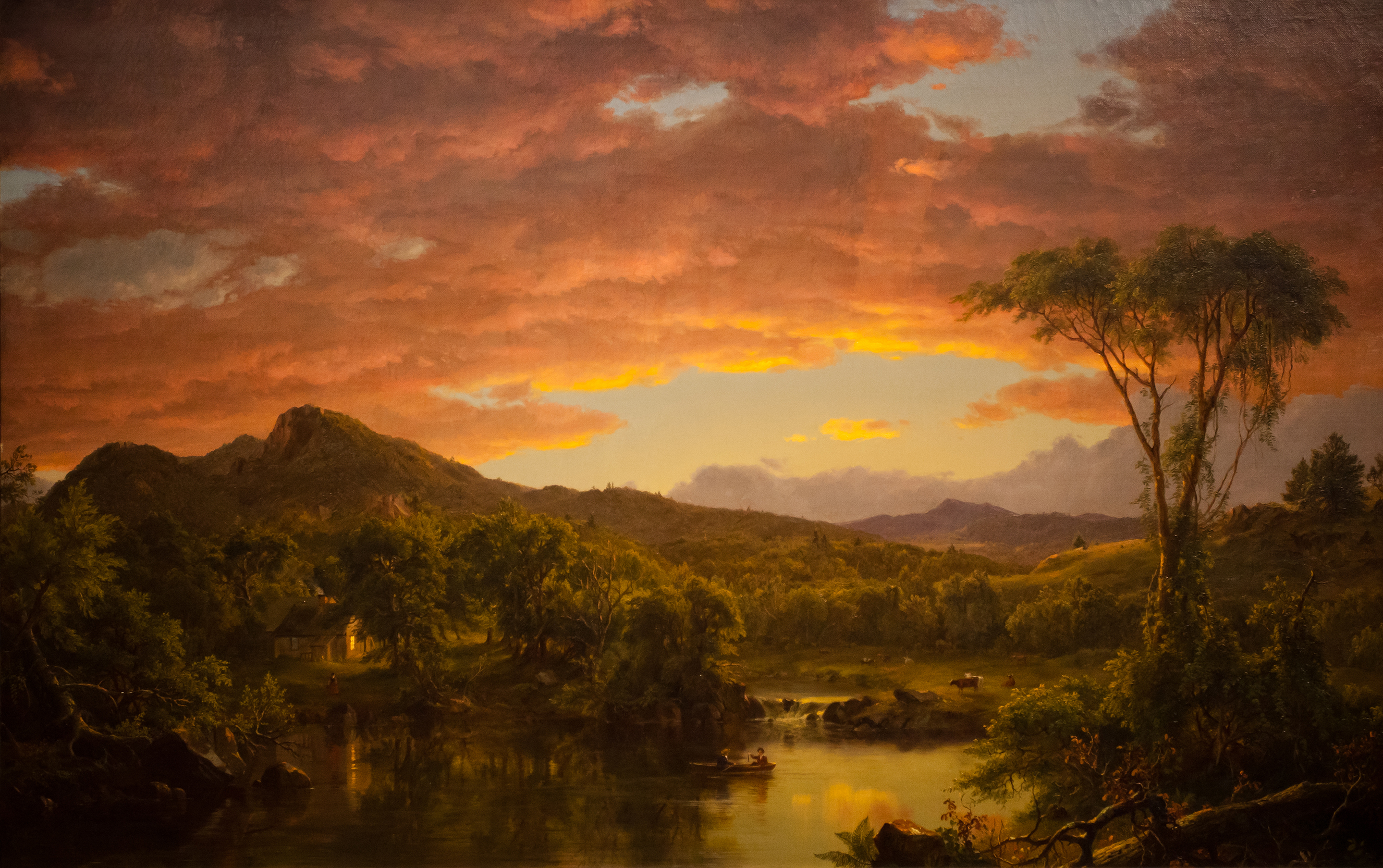
Transcendentalists felt humans were at their best in a state of self-reliance and freedom. They believed that society corrupts individuals and removes them from a natural way of life; an ongoing source of contemplation and struggle. Perhaps for this reason, these paintings continue to call out to the human spirit in a time when a significant number of people are exiting large cities in search of a more agrarian lifestyle.
“Society has parted man from man, neglectful of the universal heart.” —William Wordsworth
Romantic and Transcendentalist paintings hold a timeless significance for humanity. They remind us that the human experience is so much more than staring at screens. For them, a larger being not only created the world, but is the source of life within it. As humanity enters a “fourth industrial revolution,” an “internet of things” composed of radiation-based technologies further threatens the natural world; birds, bees, trees, humans, and all. It would serve us well to consider the cumulative impacts of our actions, and our addictions, on the world and on ourselves, both seen and unseen. A more beautiful world awaits our humbled participation.
Jeff Perkin is a graphic artist and an Integrative Nutrition Health Coach available at WholySelf.com





Be the first to comment